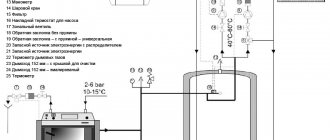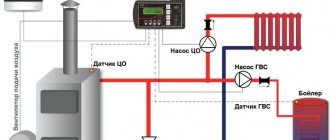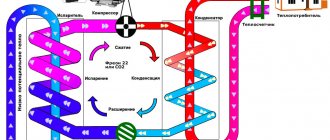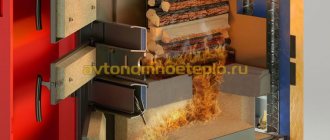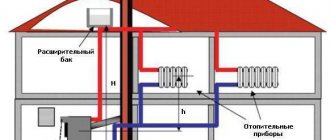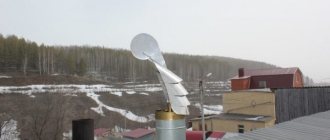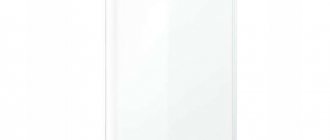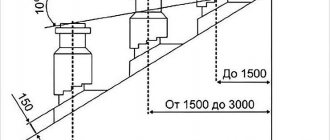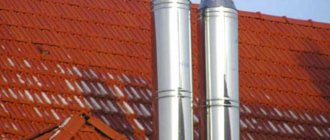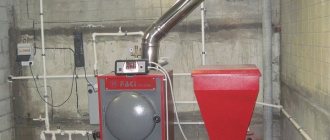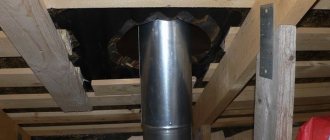One of the most important parts of a solid fuel boiler is the chimney.
Through it, flue gases and soot are released into the atmosphere. It ensures high boiler operating efficiency and high efficiency. Intensive use of the chimney pipe leads to clogging. The cross section decreases, combustion products cannot pass through quickly. As a result, traction decreases, the device begins to work in heavy duty, and efficiency decreases.
To prevent soot accumulation and for the boiler to function normally, the chimney pipe must be made of appropriate materials according to well-executed drawings. In addition, it is very important to correctly calculate the diameter and cross-section.
Traction
When the system has insufficient thrust, poor fuel burn occurs. As a result, soot is formed. It gradually clogs the pipe passage, reducing its cross-section.
You can, of course, achieve increased draft by increasing the cross-section of the chimney pipe. But this will not lead to a positive result. The heat from the boiler will simply leave the room through the pipe. To be able to regulate the draft, the boiler is equipped with special dampers.
The appearance of draft is based on the difference in temperature between the room and the environment. The draft becomes maximum when the cold weather sets in. A small temperature difference is enough so that combustion products do not settle on the surface of the pipe, but escape into the atmosphere. This can happen under one condition. The chimney must be properly designed and installed.
When the boiler starts working, outside air is supplied to the combustion chamber. Due to this, the combustion process is supported. Exhaust gases are directed into the chimney and quickly thrown out.
If the pipe diameter is insufficient, exhaust gases begin to accumulate inside the combustion chamber. As a result, the fire begins to fade, and there is heavy smoke in the room.
The traction force depends on several factors:
- Pipe length.
- Presence of turns.
- Bends.
For example, the presence of a right angle in a structure greatly reduces its maneuverability. This becomes noticeable when the atmospheric pressure decreases. To correct this situation, a special stabilizer is installed in the rod.
Chimney draft force
The selection of a chimney design and its installation must be approached responsibly, paying attention to the slightest nuances. Not only the efficiency of heating equipment, but also the safety of people living in the house depends on this.
Before purchasing a chimney for a heating boiler, you need to determine the draft force necessary for the correct operation of the equipment. This parameter is a technical characteristic of the smoke exhaust system, which reflects its performance and quality of operation.
The speed of movement of flue gases, formed as a result of the collision of air flows having different temperatures, and pressure drops in the combustion chamber, depends on the draft in the pipe of the unit.
The draft force is influenced by a number of factors, important of which are the length and diameter of the chimney pipe for a solid fuel boiler, the presence of turns and bends in it. It is important to know that this indicator will be highest if the installed pipe is as straight as possible and narrows towards the outlet. It is for this reason that when designing a heating system and choosing a unit, it is necessary to reduce the turns, bends and slopes of the chimney to a minimum.
The quality of operation of the hood is characterized by the following parameters:
- Too much traction . In this case, a hum appears in the chimneys of solid fuel heating boilers. To eliminate it, use a special gate - this is what the damper is called. It allows you to effectively adjust the traction force and thereby achieve optimal performance.
- Low level . The reason is the penetration of flue gases and smoke into the boiler room. If such signs are observed when testing the chimney, it is necessary to ensure that the design is correct. According to current standards, the length of the gas exhaust pipeline must be at least 5 meters, and the height of the pipe for a solid fuel boiler must exceed the height of the roof ridge by 1 meter.
Additional features of the chimney
It should not react to high temperatures. Therefore, a chimney made of particularly heat-resistant materials is installed in a solid fuel boiler. When coal or wood burns in such a boiler, the temperature of the smoke is much higher than the temperature of gas combustion. For example, the smoke temperature of a gas boiler does not exceed 200 degrees. When wood burns, the temperature can exceed 300 degrees. If the boiler is heated with coal, the temperature reaches 600 degrees. Sometimes the temperature jumps. It begins to rise when heated.
It is prohibited to ignite the combustion chamber with solid fuel, gasoline, or other flammable substances. This option can cause a soot fire due to a burnt-out chimney. It is strictly forbidden to try to remove contaminants in this way.
Chimney made of ceramic pipes
No less common than the brick method is the method using ceramic pipes. This solution can be called universal, capable of being suitable for almost any situation.
The convenient thing is that such chimneys are suitable for almost any type of boiler offered on the market today.
In addition, it is the chimney made of ceramic pipes that is the most durable.
The only subtlety will be determining the permissible and maximum temperature of the gases leaving the boiler - depending on this, the pipes themselves are purchased.
If you purchase a solid fuel boiler, you need to use pipes that can withstand 600-650 degrees, as well as fire-resistant and protected from soot formation.
If you plan to use boilers purely on gas, then pipes that can withstand 400-450 degrees are relevant for such devices; in addition, they are ideal for working in a wet state (for this they are specially equipped with condensate drains).
Chimney created using pipes
These types of chimneys are relatively clean and resistant to the formation of soot and other contamination, and thanks to their smooth surface, they are easy to clean.
It is also convenient to construct such a chimney - several separate elements are needed (these are pipes, the length of which ranges from 60 cm to a meter). These pipes must be connected to each other using fittings, and in addition, the connection points are treated with acid-resistant adhesive mastic.
In cross-section, such a chimney looks like this: in the center there is a ceramic pipe itself, then the next layer is insulation, and then a shell of concrete blocks is needed (most often elements with special holes are used - they will be necessary to provide ventilation, as well as for reinforcement ).
How to calculate chimney sections
When choosing, you need to first measure the existing cross-section of the pipe. It should have the same dimensions. It is desirable that the sizes match. If the diameter is larger, a drop in pressure will occur and the traction force will decrease. It is prohibited to operate two solid fuel boilers with one chimney. Each must be equipped with a separate pipe. With the correct selection of diameter, as well as competent installation, there will always be good traction.
The cross-sectional size (sq. m) is determined by the formula:
volume of fuel consumed (m3/s) / gas velocity.
The chimney can have different cross-sectional shapes:
- Circle.
- Rectangle.
For normal operation, you can use any option, but a round section is still much preferable. When smoke moves inside the pipe, it spirals. Any foreign part in the pipe creates resistance to the movement of the gas flow.
If the inner surface of the pipe is rough, the gas velocity will decrease. When smoke, during circular movements, collides with a right angle, a sharp change in trajectory occurs, and mixing occurs. As a result, soot settles in the corners.
Constant, thorough cleaning will be required.
Non-specialized information about parts of the smoke exhaust system
We will start with a solid fuel boiler, which is a classic type heating device. It can be found in almost every private house where there is no gas supply. It is ergonomic in that it is possible to burn coal, wood, and peat in the fuel chamber.
To get greater heat transfer from the equipment, you need to correctly calculate and make a chimney, in our case from brick.
It must meet the following requirements:
- do not imagine any obstacles to the supply of air necessary for the efficient operation of the heating device,
- create a draft that appears due to the difference in temperature and pressure, sufficient to remove combustion products.
Chimneys for a solid fuel boiler can be made from:
- bricks,
- steel of certain grades,
- ceramics.
The classic option is a brick chimney, which you can make yourself.
Installation Rules
Often homeowners are in a hurry or they come across careless workers who are confident that they can easily deviate from generally accepted requirements. As a result, accidents occur, which, alas, can end in death.
To prevent this from happening to you, we strongly recommend that you follow the tips below:
| Fire safety |
|
| Height |
|
| Condensate drainage | The instructions require that this condition be fulfilled for any type of chimney. It is necessary to provide places for condensate discharge for maintenance, and cleaning from soot and possible debris. Otherwise, the draft will slowly decrease so that smoke will flow into the room. |
| Section | The internal cross-sectional area along the entire length of the pipe must be uniform. Otherwise, this will greatly impair the passage of combustion products. |
| Additionally |
|
Why do many people prefer a brick chimney? This depends on the fact that the exhaust gases can heat up to a temperature of 600? C, based on this, the design must be resistant to it.
Brick best corresponds to this parameter, despite the fact that the cost of laying a chimney, and the material itself, is now not so inexpensive. But after the installation is complete, you may not have to worry about it for a long time.
Advice: apply a fireproof mortar to the internal walls of a brick chimney at the time of its construction and then you can protect it from the negative effects of aggressive acidic sediment and condensate.
How to lay a brick chimney
Laying a brick chimney cannot be called an easy task; this will require certain knowledge and skills in order to understand the technological processes.
- A simple option is to install a chimney, at a time when a brick channel needs to be made into the walls. In this case, an unfilled shaft with a cross-section of a brick (250 mm) is left. The cross-section of the chimney can be calculated according to the following standards: 1 kW = 0.08 m2. Accordingly, if the power of a solid fuel boiler is 10 kW, the cross-section of the chimney brick pipe should be at least 0.8 m2 or approximately 300x300 mm.
- When creating a separate chimney, you must exercise increased caution and responsibility in your work. When laying, pay special attention to the corners, which should be perfectly even. In addition, make sure that there are no bulges on the walls.
Advice: a chimney that is not adjacent to the wall must be constructed strictly in a vertical plane.
- For reliability, the chimney adjacent to the wall must be additionally secured with anchors, which must be placed approximately 4-5 rows apart. In this case, you should also first consider where the technological and inspection holes will be located.
Advice: be sure to make a hatch at the bottom of the chimney through which accumulated soot can be easily removed.
- In order to increase the efficiency of the structure, the inner surface of the pipe must be flat and smooth, then the smoke can freely escape out.
- One of the most common options used for interior finishing of the channel is “mitten-like” plastering. Thanks to the use of this method, its cross-section in shape will be as close as possible to a circle. Despite the fact that some experts consider this method of interior finishing to be impractical, since after some time the plaster solution will begin to peel off and clog the chimney channel.
Advice: cover the outer part of the chimney with facing bricks or cover it with roofing material in order to protect it from atmospheric influences.
What you need to prepare for work
The simplicity of the structure lies in the fact that for its construction it is enough to have brick and mortar on hand for laying it.
But you don’t need to look down on the work, it needs to be done according to all the rules and very carefully, otherwise your heating system simply will not work properly and the pipe will need to be disassembled and repositioned, and this is a huge expense.
- When choosing a brick, make sure that it is well fired. The coloring of the material should be uniform on all sides. The edges are smooth and clear, which makes it possible to make seams of small thickness.
- Prepare the solution using a special method and necessarily include sand, clay, cement and water in its composition. Particularly important is the selection of sand, which should be small, which will make the solution more plastic.
- Prepare the following tools:
- trowel,
- pickaxe hammer,
- roulette,
- building level and plumb line,
- shovel for mortar,
- construction line.
Features of masonry
- Start work directly from the heating device.
- It is possible to connect the boiler to a brick chimney with a pipe of the appropriate size and diameter.
- The masonry must be carried out with bandaging between the rows. In principle, it resembles the construction of partitions or walls, despite the fact that there are some features that need to be taken into account:
- Be sure to check any row with a level in the vertical and horizontal planes,
- clay must be mixed in the solution,
- The seam thickness should be approximately 5-10 mm. We do not recommend doing more, since due to periodic temperature changes the solution will begin to crumble, and this will inevitably lead to the destruction of the chimney,
- the sealing of all seams must be of high quality, through holes are not allowed,
- when laying, use only whole bricks, minimizing the use of halves as much as possible.
What materials should exhaust pipes be made of?
With a wide variety of materials, only a few types can be used to operate a chimney. The main ones are:
- Brick.
- Metal.
- Ceramics.
The most popular are pipes made of brick.
They are able to withstand very high temperatures. Its maximum reaches 1000 degrees. Today, on the roof of modern expensive cottages you can see an original chimney made of eurobrick. However, upon closer examination, you can see pipes inserted inside the brick chimney. They can be steel or made of ceramic. This is explained very simply. One brick is not suitable for normal operation. In other words, it will work, but not for very long. It will quickly be destroyed by caustic condensation. Therefore, a liner is inserted into the brick pipe. Free cavities are filled with insulating material. Sandwich pipes made of ceramics can withstand very high temperatures. It can exceed 1200 degrees. This value is much higher than the maximum smoke temperature after coal combustion.
Such a pipe is not afraid of condensation and any atmospheric phenomena. Condensate is drained through a special drain hole. Sometimes for this purpose an additional container is made at the end of the watering can. A ceramic chimney pipe is installed on the facade or inside the building.
A chimney of the Schiedel Uni brand, if a soot fire occurs, is able to cope with such a thermal load. When burning, soot heats up to a temperature of 1100 - 1200 degrees.
Disadvantages of ceramics
They do not have a beautiful appearance. Their cost is much higher than their steel counterparts. Installing these pipes requires construction skills and experience. These pipes remain popular among consumers with low incomes.
Metal chimney
For its manufacture, ordinary steel or stainless steel is used. Unfortunately, steel chimneys cannot withstand
aggressive environment. When the boiler operates continuously, the pipe will become unusable in a very short time and may cause a fire.
The composition of the stainless steel used includes special additives consisting of several chemical elements
- Titanium.
- Nickel.
- Molybdenum.
They are the ones who save stainless steel from corrosion. For installation
The following steel grades are used in boilers:
- 316.
- 316 L.
- 321.
They contain substances that allow steel to withstand temperatures within 700 - 800 degrees. These grades of steel are not afraid of condensation, they are neutral to acids, and do not react with other aggressive substances.
The cost of a chimney made of stainless steel is affordable to the average buyer. It is considered most suitable for installation in a solid fuel boiler.
Glass chimney
Very rare. Its positive qualities include:
- Low thermal inertia.
- Corrosion never occurs.
- Original look.
The cost of such a design is very high. Therefore it is very rare. In addition, its installation is very labor-intensive and costs a lot of money.
Why insulate a chimney for a solid fuel boiler?
Why do you need to insulate a chimney for a solid fuel boiler? To ensure that the flue gases leaving the boiler do not cool too quickly. Modern TT boilers are already devices with the highest possible efficiency. This means that the boiler design ensures maximum “recovery” of thermal energy from the flue gases as they “travel” through the boiler heat exchanger.
This means that the outgoing flue gases, entering the chimney, already have an extremely low temperature. And if they continue to give off heat through the walls of the pipe into the surrounding rooms or street air, then their movement will slow down more and more. This means that again there will be no normal draft in the chimney.
To prevent this from happening, the chimney pipe for a solid fuel boiler or stove must be insulated. For this purpose, the easiest way is to use ready-made sandwiches, which are double cylinders made of stainless steel, the space between which is filled with basalt insulation or vermiculite.
The better the sandwich is insulated, the less temperature the outgoing flue gases lose, and the better the draft in such a chimney compared to an uninsulated one.
A chimney pipe for a solid fuel boiler, assembled from sandwiches of 1.0 and 0.5 meters, has a number of other advantages, in addition to the main one - improving draft:
- Easy to assemble, because easy installation of sections of 0.5 and 1.0 meters is possible
- Corrosion resistance of stainless steel to external precipitation and condensate in the pipe
- Convenient removal of condensate from the chimney using a drain valve on the tee
- Attractive appearance, you can run a pipe made of sandwiches along the facade of the house
In addition to using sandwiches, an insulated chimney for a solid fuel boiler can be obtained in 3 more ways:
- Insulate the old chimney with basalt insulation or vermiculite.
- Use an old brick pipe from a boiler or furnace, lining it with stainless pipe inserts.
- Install an insulated ceramic chimney
The first two methods belong to the budget category. The third method is the most expensive. But it will make you forget about the “chimney issue” for many years.
The chimney structure for a solid fuel boiler made of ceramic sections is clearly visible in the diagram below.
Such a chimney is not afraid of condensation and is not subject to corrosion. In addition, a ceramic pipe is extremely fire resistant and does not burn out like steel.
More on this topic on our website:
- What are the rules and regulations for installing a wall-mounted gas boiler? Installing a heating boiler is not an easy task. The boiler cannot be hung haphazardly, because depending on how correctly the wall-mounted boiler is installed…
- Installing a solid fuel boiler with your own hands - correct connection and piping Here, three opponents in the comments are telling me that installing a solid fuel boiler with your own hands cannot be done. What…
- We choose a backup power supply for the boiler - generator, UPS, inverter. Winter, frost, smoke from the chimney. The picture is like a postcard. A good owner prepared in advance, the boiler was installed in the fall, it works perfectly, heats...
- Chimney topic - which chimney to use for a boiler Today we’ll talk a little about how flue gases can be removed from boilers, what a chimney pipe for a gas boiler should be...
Device and installation
When installing a metal chimney, work starts from the bottom, gradually moving upward. Pipes can be connected in several ways:
- By the movement of smoke.
- For condensate
When the boiler is connected to the chimney according to the first option, installation occurs from the boiler. The second option, on the contrary, goes to the boiler. The metal structure consists of several parts:
- Cup.
- Pipe sandwich.
- Condensate collector.
- Spark arrestor.
- Header.
- Cleaner.
To create a reliable connection, establish:
- Adapters.
- Tees.
The joints are fastened with clamps from the outside.
Technological requirements
The following technical requirements must be observed:
- A special area must be provided to disperse the smoke. It is a vertical pipe installed behind the nozzle of a solid fuel boiler. The acceleration section is made one meter high.
- The chimney is installed only vertically. Deviation of no more than 30 degrees is allowed.
- Deflections are prohibited.
- The length is very important (3 - 6 meters).
- Three horizontal sections are allowed. Moreover, the length of each should not exceed half a meter.
- The height of the head above the roof must exceed 100 cm.
- The pipe is attached to the wall in 1.5 meter increments.
- To create a sealed joint, the pipes are generously lubricated with heat-resistant sealant.
To obtain ideal draft, it is necessary that the chimney design has a minimum number of turns. A straight pipe is considered best.
The chimney can be installed inside or outside the building. For the first option, it is necessary to protect the pipe so that it does not come into contact with flammable materials. A special metal screen is used, installed where the pipe passes through the ceiling. The chimney must be located at a distance of more than 25 cm from the wall.
External structures look much safer. They are much easier to maintain. Masters consider this method the most preferable.
Basic moments
One of the key parameters of a chimney is its cross-sectional area. It must be selected by the user according to the requirements of the manufacturer of water heating equipment. It is important that the horizontal sections are no longer than a meter, and the maximum height of the chimney is selected according to the recommendations of the boiler manufacturer. In most cases, the height of the structure does not exceed five meters. Higher channels are not recommended for home use.
The correct design of a chimney for a solid fuel boiler can be considered the fact of effective removal of condensate that forms on the walls of the structure during operation of the boiler. In addition, the user must think in advance about how the soot will be removed. Remember that convenient maintenance of your exhaust system is of utmost importance.
Pipe height
This size is determined by SNiP, which sets certain parameters:
- If the roof is flat, the chimney should rise 1.2 meters above it.
- If the chimney is located near the ridge, and the distance is less than 1.5 meters, it should rise above the ridge by 0.5 meters or more.
- When the pipe is located in the range of 1.5 - 3 meters to the ridge, it should not be below the ridge line.
- If the location of the chimney from the ridge exceeds 3 meters, its height should be on a line extending from the ridge, maintaining an angle of 10 degrees relative to the horizon line.
To determine the height of the chimney, a large number of indicators are taken into account. The parameters presented above apply only to gas equipment. To make an accurate calculation, you need to use the services of a specialized company.
Selection of chimney pipes
Selecting a chimney for solid fuel heating appliances is not easy, since the materials for them and design options are presented in the retail chain in a huge variety.
To select a specific chimney design, a number of important parameters must be taken into account, including:
- temperature of the exhaust flue gases - each material of its manufacture has its own temperature maximum, so the degree of their heating should not exceed the established parameter;
- gas pressure in the pipe - today, each type of pipe product is designed to operate at a certain value of this characteristic, implying natural draft or pressurization; universal models are also available for sale;
- presence of condensate – brick pipelines must be operated under certain conditions that exclude the possibility of condensation;
- corrosion resistance - there are 3 classes of resistance of chimneys to corrosive processes, but only two of them - 2nd and 3rd - are designed for solid fuel units;
- minimum distance to flammable materials that can ignite from high temperatures - this parameter is indicated by manufacturers in the technical documentation for pipelines.
To find out some of the above parameters, you need to calculate the chimney for a solid fuel boiler. It is advisable to entrust these calculations to an experienced design engineer of heating structures and systems.
Fire safety technology
It is allowed to install a chimney in accordance with the requirements:
SNiP 2.04.05–91U.
DBN B 2.5-20–200.
NAPB A.01.001–2004.
Installation should only be carried out by professionals. The cross-section of the chimney must correspond to the value specified by the manufacturer in the instructions supplied with the boiler.
The required chimney height is usually recommended by the manufacturer, or it must exceed 5 meters.
If there is a horizontal section, its length should not exceed one meter.
The design must provide for the possibility of draining condensate, as well as cleaning the smoke exhaust channel.
How to connect a chimney
All connections of parts to the nozzle of a solid fuel boiler are made with a heat-resistant sealant that can withstand temperatures in the range of 1250-1500 degrees.
When the diameter of the chimney does not match the size of the chimney outlet, an adapter is installed to create a tight joint.
How the parts are assembled
Any single-walled, as well as sandwich, with insulation, are assembled in only one option: “pipe is inserted into pipe.” The connection points of the chimney parts do not require the installation of additional clamps.
If the structure is made of special stainless steel, assembly is carried out only using condensate. In this case, condensate, as well as the resulting tar deposits, will never get out; they will flow along the walls of the pipe directly into the condensate drain.
If a revision is used in the chimney and tees are installed, all parts are assembled “according to the smoke.” The assembly of vertical parts extending from the tee is carried out “using condensate”.
If it is necessary to line the channel, the gap formed between the pipe and the channel must be more than 4 cm. It is necessary when the metal expands when heated.
To ensure that the chimney sandwich parts have a more rigid fastening, rivets are installed or screws are screwed in.
Fixing the chimney
The pipe is attached to the wall only with special materials.
The single-wall structure must be fastened with a fastening step of 1.5 meters on all vertical sections of the pipe.
If the sandwich chimney does not have a supporting structure, it is necessary to secure each element.
If the system uses a 45–87 degree tee or a 45–90 degree elbow, installation is carried out in such a way that the load on the rotating parts of these parts is completely eliminated.
If installation requires additional support, use a floor stand installed under the inspection.
When the chimney pipe is raised above the roof by more than 1.5 meters, a bracket must be installed under the brace.
Passage through floors
To make a passage through the wall of a house or its ceiling, it is necessary to use the building codes that are in force in Ukraine today.
If a sandwich chimney with insulation passes through wooden walls, a liner must be installed and another layer of thermal insulation is applied.
When a chimney pipe is installed through the roof, builders must install a special additional pipe part, the so-called “roof”. Another additional layer is created, consisting of fireproof insulating materials.
The final stage of construction
When a brick chimney is lined, its upper part is covered with an additional part - the end.
Usually the top of the pipe is covered with a baffle or a beautiful fungus.
If the building's roof covering is made of a fire-hazardous material, such as bitumen shingles, a special spark arrestor is mounted on the top of the chimney.
If a gas boiler is installed in the house, installing a deflector is strictly prohibited. According to current regulations, the upper part of the gas device pipe is always kept open.
Chimney requirements
Requirements for the chimney
Before starting to build a chimney, we recommend that you thoroughly study the operating instructions supplied with the boiler. This document contains strict requirements for what parameters a chimney should have that is ideal for a given boiler model. In the absence of such information (or with complete confidence in your skills), you can build it, choosing the material at your discretion. Key requirements that cannot be ignored:
- To effectively remove gas, the chimney must have the most vertical design.
- The cross-sectional areas of the pipe and the boiler outlet pipe must be at least equal, and it is better if the first is larger than the second.
- A deflector (head) is required.
- If the roof material is highly flammable, the system must be equipped with a spark arrestor.
- The deflector must be mounted in the area of wind pressure.
How to determine the wind support zone? Find the highest point of the nearest obstacle that changes the direction of the air masses. This could be a tree, a neighboring building, or a roof ridge. From this point it is necessary to draw a straight line to the chimney at an angle of 45˚. Everything that is under it will be included in the wind support space. At a certain wind direction, air from this zone disrupts the draft, enhances it (fuel consumption increases, boiler efficiency decreases), or completely reverses it.
The chimney is assembled very simply, by alternately inserting its elements into each other. But this installation is divided into two ways:
- By condensate. The components are connected taking into account the direction of condensate drainage. This is necessary in a system that is not equipped with an evaporation collector.
- By the smoke. The design parts are connected in accordance with where the gas moves.
In systems with a condensate collector, part of the structure is assembled according to the first principle, and the rest - according to the second.
